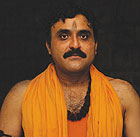|
Sinha Pranayama
|

|
|
|
Pranayama—literally translated it means salutation to the Prana. Our health and vitality, our emotional and financial state, diseases and glowing health are all dependent on the frequency of prana that vibrates in and around us. The complete system of our pranic body of the chakras, nadis and koshas are dependent on the prana that we are receiving from the environment around us. But to be able to retain the vital prana the nadis and chakra of the Pranamaya Kosha should be clean and pure, there should be no blocks, i.e. the movement of prana in them should be clean and uninterrupted.
Sinha Pranayama
In the last issue we discussed the ujyai pranayama in the issue we will discuss sinha pranayama. This pranayam is a vitalising one. Its major effect is on the Pranamaya Kosha, where it opens the blocks and has a tendency to balance the prana. Immediately after the pranayama, the body feels light and revitalised. This is simply because a balance is made at the pranic level, which makes you feel physically good.
Sit in vajra asana bending slightly forward, hands on the knees, and with your right eye look at the left eyebrow and with your left eye look at the right eyebrow (Shambhavi mudra). Hang your tongue out as much as possible. Eyes are to be open. Next, start exhaling rapidly by pulling your stomach in. The inhalation takes place automatically. Do this for at least fifty counts, and at the most hundred counts.
Next, pull the tongue back in, the eyes become normal and sitting in vajra asana, let your breath flow at its natural rhythm. Do not try to force the breathing—whatever speed, the breath moves on its own, just let that be. Observe your breath at the nostrils without any kind of strain. Relax the body completely. Open your eyes with a smile after five minutes.
Things to remember: Sit in a well ventilated room wearing comfortable clothes.There should not be a direct draught of air. Pranayama is not to be done in an environment that is too breezy or dusty
Doing of pranayama in an unsupervised manner either by copying from TV or reading from somewhere can cause long term imbalances, with difficult to cure symptoms. Therefore, the importance of learning from a Guru cannot be over emphasised.
|
|
|
|
—The writer Yogi Ashwini Ji is the
head of Dhyan Foundation, Delhi.
For Details contact: ashwiniyogi@yahoo.co.in
|
|
|
|
|
|
September 2007
|
|


|
|
|
|